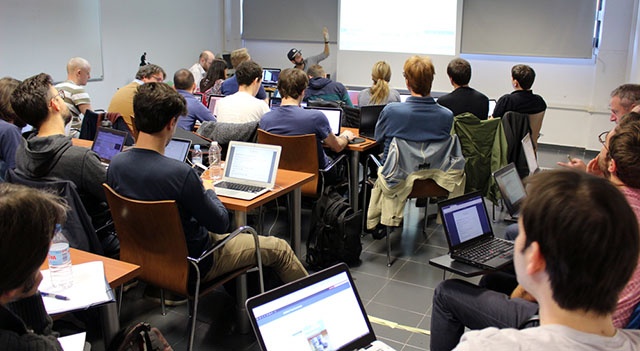Around fifty young researchers who work in what will be the largest neutrino telescope of the world KM3NeT, come from today until 17 November to the facilities of the Institute for Corpuscular Physics (IFIC) in the Parc Científic of the Universitat de València, in order to participate in the first boot camp of this international experiment in which are collaborating 15 countries.
It is the first time that this event is organised in collaboration, with the aim of train PhD and postdoc students of the experiment in the use of tools used by KM3NeT. The IFIC, joint centre of CSIC and Universitat de València, coordinates the Spanish participation in this experiment.
Juan de Dios Zornoza, IFIC researcher and responsible for the organization of the event, explains that the main objective is to train the new students of the experiment in software and analysis tools used in the collaboration. It will also be a good chance for other KM3NeT members to catch up on the latest developments.
Several KM3NeT experts will guide participants in practical sessions with a variety of examples, including simulations, computation, statistical methods and data analysis. Part of the course will also discuss the organization of future simulations and software developments by experts and researchers.
This is the first time this training event has been held in the KM3NeT collaboration, where 15 countries participate (Germany, Cyprus, Spain, France, Georgia, Greece, Holland, Ireland, Italy, Morocco, Poland, Romania, Russia, United Kingdom and South Africa.)
KM3NeT consist of multiples detection lines of 700m long each one, made up of 18 digital optical modules that house 31 photomultipliers each. These devices detect the Cherenkov light produced by the interaction of high-energy neutrinos whose origin lies outside of our Solar System. The aim is to study the Universe by means of this elementary particle, one more advance in the new Multi-messenger astronomy that has highlighted LIGO-Virgo with the detection of gravitational waves.
This lines are submerged at 3,000 m depth in the Mediterranean, which acts as a detector for these high-energy neutrinos. Nowadays, detection lines are being deployed in two of the three chosen places to locate KM3NeT: the coasts of Capo Passero, near Sicily (Italy), and Toulon (France), which will be KM3NeT-ARCA and KM3NeT-ORCA, respectively. The next location is in Pylos (Greece) The European Strategy Forum on Research Infrastructures (ESFRI) included KM3NeT in its list of strategic scientific infrastructures of 2016, and the European Consortium of Astroparticle Physics (APPEC) expresses its strong support for the experiment in its last document with the European Strategy of Astroparticle Physics.
The participation of the IFIC group in the KM3NeT project has several aspects. On the one hand, the group is responsible for the design of electronics of the called Logic Boards which process the signals detected in the photomultipliers. It also coordinates the temporary calibration of the detector, with responsibilities both at the hardware and analysis level to carry out aforesaid calibration. Regarding physics analysis, the main contributions are focused on the search for point sources, dark matter and the determination of the hierarchy of the neutrinos mass.


